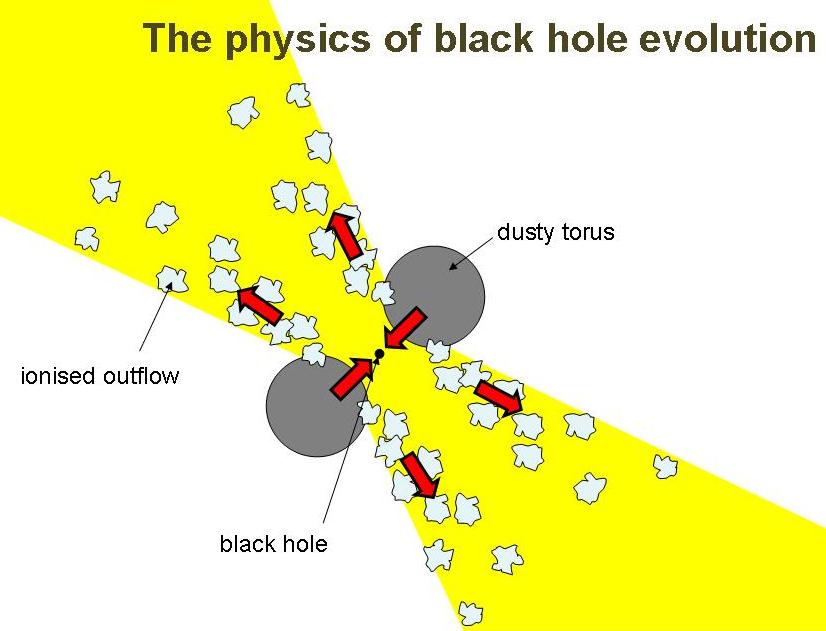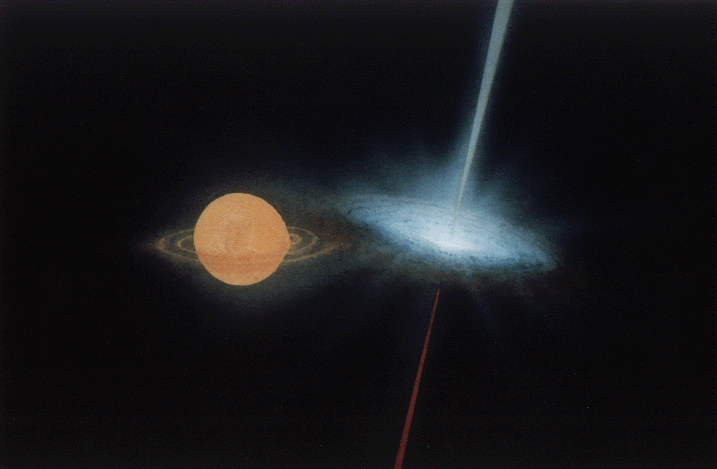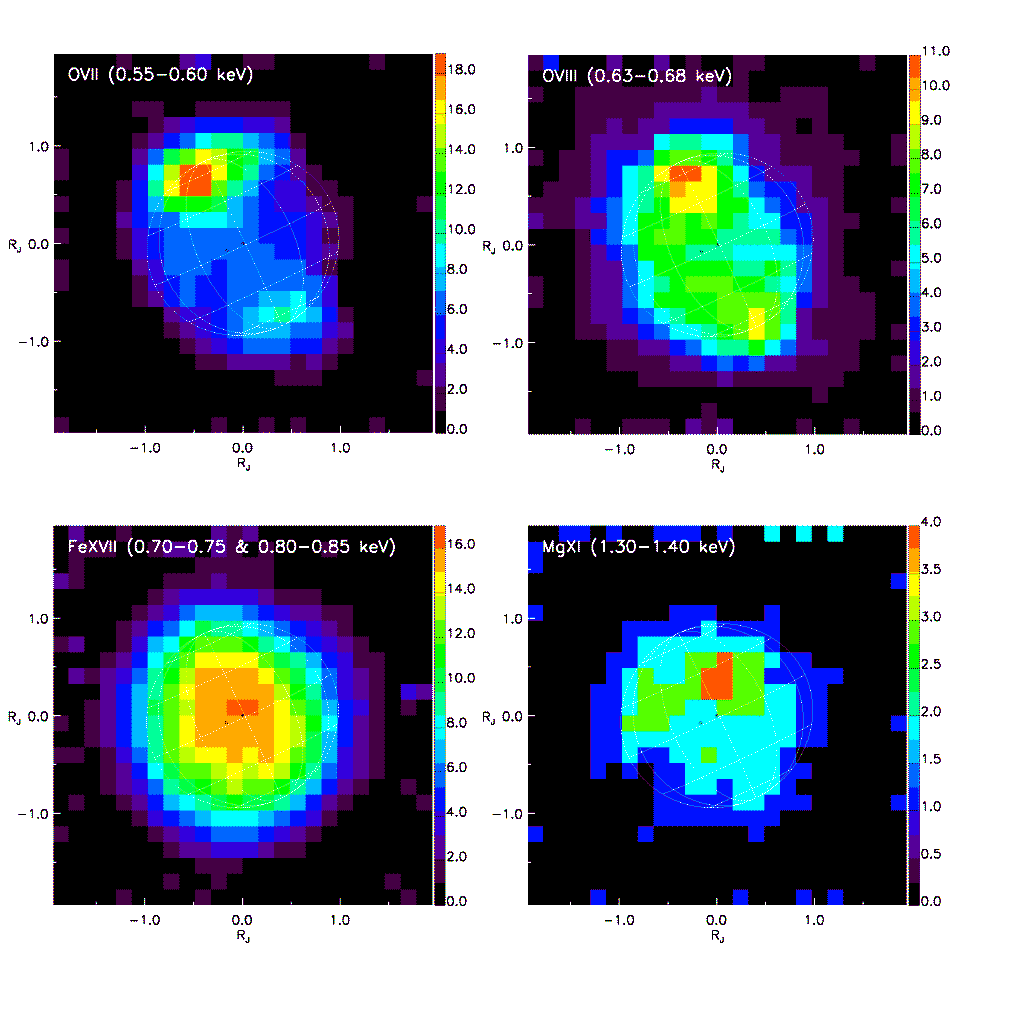|
|
|
MSSL Astrophysics Group Research Interests
Group Members (to see the full list, please click the Contacts.)
Active Galactic NucleiActive galaxies produce very large luminosities in very small volumes near their centre. These regions, known as Active Galactic Nuclei (AGN), often out-shine the millions of stars that make up the host galaxy, being up to 10000 times more luminous than the stellar content of a typical galaxy. They are amongst the brightest and most spectacular objects in the Universe, so can be observed to very large distances, or, put in another way, to epochs when the Universe was only a fraction of its current age. Thus AGN are a very powerful tool in exploring the state of the Universe soon after the Big Bang and its evolution ever since. AGN spectra are very different from those of non-active galaxies, which emit an approximately blackbody spectrum. Over most of the electromagnetic spectrum AGN are characterised by non-thermal continua, and their energy output in the X-ray is of comparable strength to that in the optical.
The standard AGN model (Fig. 1 - above left, click on image for full-size version) consists of a galaxy containing a supermassive back hole at its centre, with a mass of up to a thousand million Suns, surrounded by an accretion disk: in this disk, material sucked in from the surrounding galaxy by the gravitational pull of the black hole inexorably spirals in towards it. A dusty torus of gas and dust is expected to exist further out, and within it are clouds of X-ray absorbing and emitting photoionised gas, moving at many thousands to tens of thousands of kilometres per second: this motion is reflected in the broad optical and X-ray emission lines we observe from this region. In recent years it has become clear that much of the gas surrounded by the torus is outflowing, in a sort of conical structure illuminated by the powerful X-ray emission from the black hole accretion disk (Fig. 2 - above right, click on image for full-size version). There are many questions that still surround these astounding objects such as: what is the structure of the photoionised, X-ray absorbing gas, and how is it linked to the evolution of the system? How are accretion disk emission and X-ray absorption connected? What effect do the different types of AGN have on their host galaxy? In order to answer these questions we must first understand the system as a whole. The effect of these supermassive black holes on their immediate environment, and on the host galaxies, is still mysterious. The interaction between galaxies and supermassive black holes is especially important, since their evolution is now known to be connected; black holes play a major but enigmatic role in the formation of structure in the Universe (a possible evolutionary scenario is shown in Fig. 3 - below left, click on image for full-size version).
At UCL-MSSL we use high-resolution soft X-ray spectroscopy (such as the XMM-Newton RGS data of NGC7469, shown in Fig. 4 - above right, click on image for full-size version) to study the ionised gas that flows out from the vicinity of supermassive black holes. The aim is to determine how fast the gas is moving, its range of ionisation and how much of it there is in our line of sight. This allows us to work out where the outflow comes from, how it is driven, how much mass it transports out into the host galaxy, and what its role might be in the co-evolution of galaxies and black holes.
Astrophysical Jets in AGN and Microquasars
Compact Binaries + Wide Field SurveysUnlike the Sun, most stars in our Galaxy orbit another star: these systems are called binary stars. Generally it takes many years for the two stars to orbit around each other. However, in recent years a small number of binary stars have been discovered which orbit on a timescale of less than 1 hour. The quickest is as fast as 5 minutes, with both stars being able to fit inside the volume of Saturn. These stars are called white dwarfs and have the same size as the Earth but weigh about the same mass as the Sun. Because the stars are so close together, gravity can pull material from one star which eventually lands on the other. As a result of this process, X-rays and optical light are emitted. These binaries are interesting for many reasons. One is that they are predicted to emit lots of gravitational waves. A second is that their observed number is a good test of certain theoretical models. The Astrophysics group at MSSL has several project whose aim is to determine how many of these systems there are and secondly to determine what powers them, which in turn, determines how strong their gravitational waves are. Currently, only 18 of them are known, but current theories predict that more than 30 million of them should exist in our Galaxy. Many of these will be too faint to detect, but more than 4000 should be easily detectable using current telescopes. It is not clear if this large discrepancy is due to the fact that we still have to find lots of them, or if it is due to the theories being incorrect. The MSSL Astrophysics group leads a project which aims to discover new `ultra compacts' using ground based optical telescopes and X-ray satellites currently orbiting the Earth. Full details of the optical strand can be found in the RApid Temporal Survey (RATS) home page. Gravitational Waves were predicted by Einstein in his General Theory of Relativity in 1916. While they have not been directly detected, their presence has been strongly supported by observations of objects including ultra compact binaries. Over time as gravitational waves are emitted, the time taken for the two stars to orbit one another changes by a small but measurable amount. We have shown that the white dwarfs in the two most compact binaries are actually getting closer over time. One model, developed by Kinwah Wu at MSSL, suggests they are being powered a bit like an electrical bulb - this has been dubbed the `electric star' model. This model has been the subject of much debate and so far it is the model which comes closest to explaining their observational properties. If this mechanism is indeed driving these systems, then it has important consequences for their gravitational signal. The European Space Agency and NASA plan to launch a space observatory called LISA in around 10 years time. It is predicted that these ultra compacts will be the first objects it detects. However, to properly interpret their gravitational signal we first have to know what is powering them. If they are powered like an electric star then their gravitational signal will be due to a combination of gravitational waves and electrical power.
Galactic Dynamics
Galaxy Formation
Gamma Ray BurstsGamma-ray bursts (GRBs) are the most energetic cosmic stellar explosions in the Universe known so far, releasing in gamma-rays alone up to 10^54 erg/sec. The prompt, high-energy emission of these events can last from milliseconds to hundreds of seconds, and a bimodal distribution in the duration of their prompt emission, with a threshold at approximately 2 sec, identifies two primary classes of GRBs; short and long. They occur at cosmological distances at a rate of approximately 1 per day, and are followed by an "afterglow" emission across the electromagnetic spectrum, from the X-ray band through optical to radio wavelengths, which exhibit a peculier power-law decay that can last for weeks. Their high energy emission is unaffected by intervening absorption systems, which, together with their vast luminosities, allows GRBs to be detected out to redshifts of 10 or more. This makes GRBs the deepest probe available to the high-redshift Universe. Spectral differences as well as differences in host galaxy type between these two groups provide distinction and support the belief that both classes of GRBs do not have the same progenitors. The favoured mechanisms to produce such a large amount of energy on such a short timescale is the creation of a black hole, either from the gravitational collapse of a massive star in the case of long GRBs, or the merger of two compact objects for short GRBs. Mounting observational evidences further indicate for a different population of progenitors for these two classes of bursts. In November of 2004 Swift was launched to capture GRBs during their earliest stages of evolution. This is the first mission built specifically to study GRBs and is equipped with three telecopes that together span the gamma-ray, X-ray and UV/optical energy range to gather the greatest amount of information from early time panchromatic observations. Since then Swift has detected over 200 GRBs, provided the first observations of long wavelength counterparts to short GRBs, and detected the highest redshift GRB to date (z=6.29 GRB 050904).
Neutron Stars
Planets
Quasar Surveys
Ultraluminous X-ray SourcesUltraluminous X-ray sources (ULXs) are the brightest class of accreting black holes outside galactic nuclei. We are studying their physical properties: mass, age, nature of the companion star feeding gas into the black hole. We are trying to find out why they appear so bright - up to 50 times more luminous than the most active black holes in our Galaxy. One possibility is that black holes in ULXs are more massive than those in the Milky Way - perhaps up to 100 times the mass of the Sun. This would reveal new aspects of star formation and evolution, necessary to produce such massive black holes. Alternatively, the emission may be beamed along our direction, or we may be looking into a collimated outflow. An essential ingredient of all scenarios is that the rate at which gas is currently falling towards the black hole is up to 100 times larger than is seen in Galactic black holes. We are investigating those sources at all energy bands (radio, infrared, optical/UV, X-rays) to understand the behaviour of the infalling gas. We want to know how much of it ends up into the black hole, and how much is instead re-ejected in winds or fast jets. We are measuring how much gravitational power is extracted by the black hole from the infalling gas, and how this process is affecting the surrounding stars and gas. |








